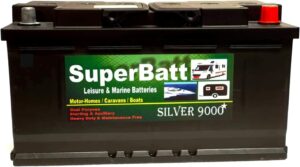Okay we are going to go through some frequently asked questions dealing with leisure batteries, to try to answer a very popular question – Which leisure battery do I need?
How to choose the best leisure battery
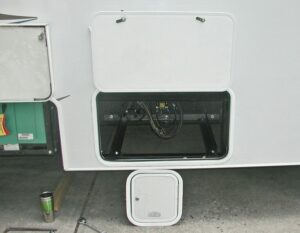
When choosing a leisure battery for your Motorhome, camper or caravan the biggest thing which dictates what battery you can have in your vehicle is the actual battery compartment size, so if you’re interested in a specific battery, make sure it can fit into your compartment.
Measure not only the length & width, but also the height available in the battery compartment.
We also need to consider is the cycle life of a battery and when I say cycle life that’s how many times the battery can be discharged from fifty percent right back up again the higher the cycle life the more the battery can do in its service period.
I have not included Lithium batteries as they require a different charging system to that found in most motorhomes or caravans & so they can’t just be swapped out, when your batteries need replacing.
To simplify the process of choosing a suitable battery the NCC have introduced a verified leisure battery scheme.
Long gone are the days where bigger heavier batteries are considered the best so the verified leisure battery scheme classifies batteries into separate groups.
Leisure batteries are now classed in 3 groups –
• Category A is for batteries with a higher storage capacity, for people who frequently use their touring caravan or motorhome away from an electrical hook-up.
• Category B batteries are aimed at those who use sites with hook-up facilities most of the time but require a greater battery capacity for when they don’t have elecrical hook-up.
• Category C batteries are for users that require a lower capacity battery to cover basic operation of their habitation equipment for rare periods away from an electrical hook-up.
Look at this chart by clicking the link below –
NCC Link
You can see the huge difference in the number of Life Cycles that the different Classes have. From 2000 for some Class A batteries, right down to 70/75 for some Class B & C batteries.
Basically “Life cycles” are the number of times a battery can be charged & flattened (to 50%) & when the battery runs out of life cycles, it’s finished & needs replacing.
So looking at the Class A batteries in the NCC chart we can also see that there can be big differences in the Life cycle numbers-
Yuasa Halfords HLB800 95 Ah 429 Life cycle
- NCC Class : A
- Dimensions (L x W x H) : 353 x 175 x 190mm
- Cycles : 400
Platinum OdysseyPC1350 95Ah 650 Life cycle
- AGM Battery Class A
- L377mm W175mm H190mm
- Cycles : 650
These two batteries are basically the same size & power, but the Platinum battery will last in theory half as long again, than the Halfords battery, but is effectively twice the price. So you need to understand what you are looking at.
Now that you understand the battery Classes use the LINKS BELOW to choose the best battery for your needs-
A good Class A Battery Choice –
Platinum 12V 100AH LB6110L 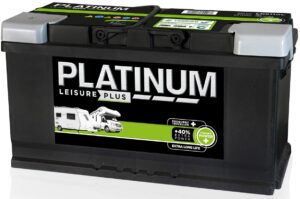
About this item
- Voltage: 12V / Capacity: 100Ah C20 / NCC Verified & Approved Battery
- Length: 354mm / Width: 175mm / Height: 190mm (Height is including Terminals / Posts)
- 3 Years Warranty. Important Note: Please do check the Dimensions (Size) and Polarity [Battery positive and negative terminal (post) Layout] and terminal type against your Old battery or Battery Tray where the battery is placed in the vehicle before purchasing (Buying) the battery from our amazon shop.
- This is an high performance Wet Cell Flooded Lead Acid Battery with Advance Calcium+ alloy Technology. This battery have strong ability for cyclic use compare to the normal leisure batteries.
12V 110AH Deep Cycle Battery VARTA HOBBY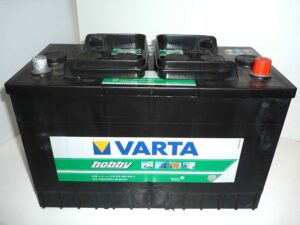
About this item
- VARTA HOBBY A28 Super Heavy Duty Ultra Deep Cycle Battery HYBRID Lead Acid Battery Starting & Deep Cycle for Leisure, Caravan, Marine, Boat, Solar Systems, Wind Turbine Energy Systems, Motor-homes, Boat-homes.
- Full 2 Years Warranty. POST LAYOUT [- +] Positive on right as in the Picture.
- Voltage: 12V : Capacity: 110AH
- Length: 347 mm / Width: 175 mm / Height: 235 mm
- Weight: 30 kg Guarantee: 2 Years
SuperBatt AGM1100 12V 120AH Ultra Deep Cycle
About this item
- Voltage: 12V ; Capacity: 120Ah @C100
- Dimensions:- Length: 354mm ; Width: 175mm ; Height: 190mm (Height is including Terminals / Posts)
- SuperBatt AGM1100 VRLA AGM Premium Leisure Battery Valve Regulated Lead Acid Absorbed Glass Mat (VRLA AGM) Ultra Deep Cycle battery 3 to 4 times more cycles than a standard Leisure Battery. Fully Sealed, Spill-proof & Safe to use battery.
- Heavy Duty Thick Grid (battery plate) with Absorbed Glass Mat Separators which holds electrolyte like a sponge to prevent acid spillage and providing up to 3 to 4 times more cycles than a standard Leisure Battery. Fully Sealed Construction: Unique sealed construction ensures NO electrolyte leakage from terminals or case. Can be fitted in any position or orientation. Gas Regeneration: Faster Recharge Capabilities due to VRLA AGM technology
- Comfortable, reinforced carrying handles. Low self-discharge rate giving extended shelf life. Designed for all climates (This battery can withstand severe temperatures). Genuine & Top-Quality best Battery in its Range. Heavy-Duty Long-Life Battery. Warranty: 2 years warranty against manufacturing faults and defects only. (conditions apply)
A good Class B Battery Choice –
A good Class C Battery Choice –
AGM or an EFB – What ?
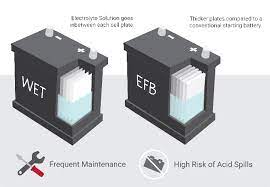
When considering your battery you’re going to want one of the latest generation battery, either an AGM or an EFB, but what do these acronyms actually mean? well apart from being a delight for anybody who loves an acronym it basically boils down to how the battery is constructed.
EFB stands for enhanced flooded battery and AGM is absorbed glass matting.
As with all lead acid batteries, they need to be vented to the outside of the motorhome or caravan & usually have their own battery compartment.
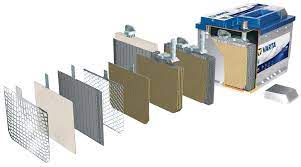
Now I’m gonna be talking a little bit about AGM battetries
AGM batteries don’t usually need a vent tube and that’s because in an AGM battery there is no free acid.
When I say free acid, that’s acid which can be allowed to move around inside the battery. Instead the acid is absorbed into the glass mat. The battery can’t then leak any acid, which is perfect if your battery has to be contained in the living area of your caravan or motorhome.

It also means it if the battery is tipped over there will be no acid that will come out of the battery.
Now saying that AGM batteries don’t need a vent is true to a point.
If there is ever a fault in the battery charging system there it can be the possibility of pressure build up inside the battery itself now there is a valve fitted to AGM batteries which if that pressure builds up it will allow the vent of any pressure from inside the battery cavity, so all batteries really need to be in a proper ventilated battery locker.
When Does a Battery Needing Charging ?
A leisure battery is pretty much an install and forget device, but they do need some attention, essentially keeping it fully charged and a good way to keep your battery fully charged is to use a smart charger.
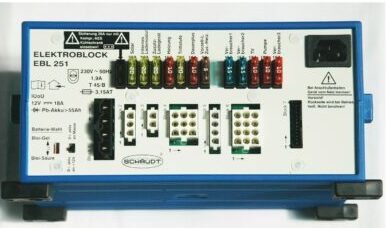
A motorhome will normally have a built in smart charger system & alternater, that charges the engine & leisure batteries, when the engine is running. Then when on EHU (electric hook up) the 240 volt charger takes over & charges the leisure batteries & sends a trickle charge to the engine batteries.
The EBL charger is a complete system, that not only smart charges the batteries, but allows for all of the motorhomes 12 volt systems to be wired in & separately fused. This system is fitted to many motorhomes.
Motorhomes these days have a variety of methods that you can check your battery indicator from the panel on the caravan as even apps and tools available to you to tell you how much charge is in the leisure batteries & start battery.
On my motorhome, if the voltage drops too much the 12 volt supply will automatically be shut off to save the batteries from the chance of permanent damage.
How Flat is Too Flat ?
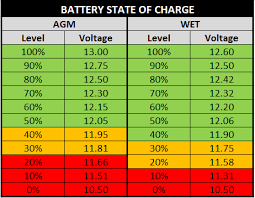
With batteries basically, anything of twelve point three nine volts or below means the battery is discharged and will need recharging and it’s really recommended that you use something like a smart charger to bring that battery back up to full charge.
You really want to make sure that the battery NEVER falls below 12.15 volts.
I have a 240v Onboard Battery Charger & Solar Charger ?
If you don’t have a solar panel charging kit, read this article to see the huge advantages – Solar Panels For A Motorhome
On most motorhomes the battery charge system will be on all the time when on EHU. They are smart control charges & will go to float ( no charge input) when the batteries are full.
When power is being drawn the charger will recognise the usage & start charging. You are effectively running the 12 volt system from the smart charger. When you then come off EHU your batteries will be at full charge.
The solar systems are connected to a charge controller & this will not allow any charge to the batteries when on EHU & the 240v charger is operating, as it will recognise that the batteries are full. Leisure batteries should stay at full.
You only have so many times that the battery can be taken down to flat ( 50% of capacity – 12.3 volts) & recharged again, before it needs replacing.
Do A Manual Check Every 6 Months
There is no substitute to physically check in the charge for your battery using a multimeter and there’s a good reason for that. When you disconnect your battery there is no power coming out of your battery and there’s no demand on it so use a multimeter they’re really inexpensive you can plug them straight on to your battery and it will give you an honest answer straight away.
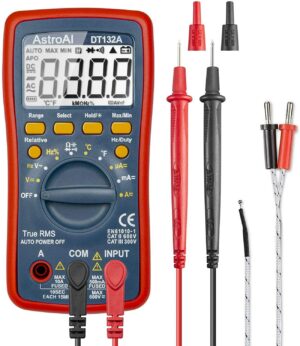
Now when I make my measurements on my battery I tend to leave the battery disconnected for a couple of hours and that gives the battery time to settle down. This is important if it’s just been charged up or but it’s also important if it’s just being used & discharged.
Leave it disconnected for a couple of hours and then make your readings.
So what do the numbers actually mean well a battery of between twelve point six and twelve point seven two means the
battery is fully charged & if the voltage remains pretty constant for a few hours then the battery is in good health.
If after a few hours the voltage has started to fall off, leave it disconnected & check it again a few hours later. If the battery falls below 12 volts, it really needs to be replaced.
A good Class A Battery Choice –
A good Class B Battery Choice –
A good Class C Battery Choice –
Thanks For Reading.
Right and there we go I hope that’s been useful for you I hope that’s answered some questions when dealing with leisure batteries there’ll always be questions and if you do have a good question when regarding leisure batteries put them in the comments below and I’ll try my best to answer them for you.


